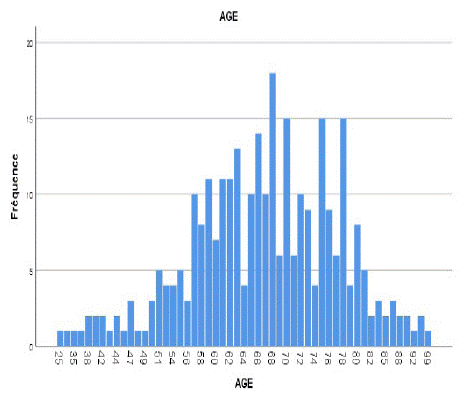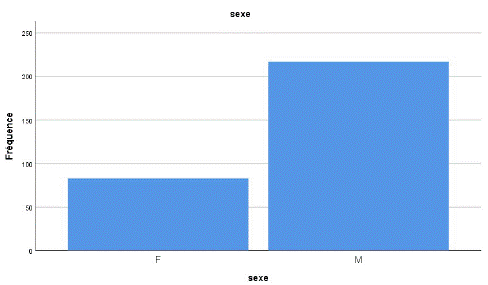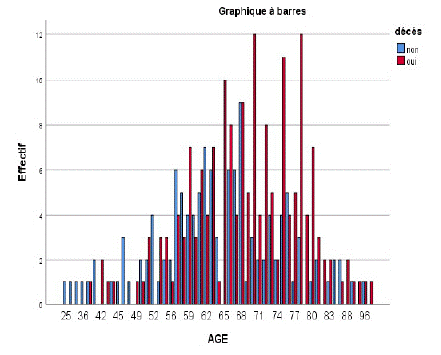
Case Series
Austin J Anesthesia and Analgesia. 2023; 11(1): 1111.
Epidemiological Profiles of COVID-19 Patients Admitted to Intensive Care
Hicham Bennani MD*; Armani E; Arjouni Y; Houba A; Doghmi N
Resuscitation Service, Department of Anesthesia Resuscitation, Mohammed V Military Hospital Rabat, Morocco
*Corresponding author: Hicham Bennani Resuscitation Service, Department of Anesthesia Resuscitation, Mohammed V military hospital Rabat, Morocco. Email: hicham.bennani.med@gmail.com
Received: March 10, 2023 Accepted: April 11, 2023 Published: April 18, 2023
Abstract
Objective: Describe the epidemiological characteristics of COVID-19 patients admitted to the intensive care unit.
Methods: This was a prospective observational study of 6 months (August 2020 to February 2021) carried out at the COVID-19 resuscitation service of the Mohammed V military hospital.
Results: During the study period, all patients tested positive for SARS-CoV-2; 300 were admitted to intensive care. The average age of patients was 67±11 years, with 217 male (72.3%) of cases, with a sex ratio (M/F) of 2.61. The majority of patients with at least one medical comorbidity 54%, including diabetes (35.7%), high blood pressure (31.8%), and obesity (29.7%). The mortality rate was 53.3% of all patients admitted to intensive care.
Conclusion: During this period all patients declared COVID-19 a small proportion of patients were admitted to intensive care. These patients were mainly elderly and male, with at least one comorbidity.
Keywords: COVID-19; Comorbidity; Mortalityrate; Intensive care
Introduction
Corona viruses are an important human pathogen, and research on their behavior dates back more than a century [1].
In late 2019, a novel coronavirus appeared in Wuhan, China, and spread around the world.
In February 2020, the World Health Organization designated COVID-19 (for coronavirus disease 2019) as the name of the human disease caused by Severe Acute Respiratory Syndrome Coronavirus 2 (SARS-CoV-2), which was previously known as 2019-nCoV [2].
SARS-CoV-2 is a member of the Coronaviridae family, enveloped in single-stranded RNA viruses. Coronaviruses are so named because of the crown seen on electron micrographs that represent their densely packaged membrane proteins [3].
From an epidemic in China to a pandemic declared by WHO on 30 January 2020 [4].
Africa was reached later than other continents, but as of May 3, all African countries had reported at least one case. As of June 9, 2020, although the numbers are likely underestimated, Africa had nearly 200,000 confirmed cases, and more than 5,000 deaths, with 25 countries having more than 1,000 active cases [5]. Viral pneumonia is the main respiratory attack caused by this virus up to severe acute respiratory failure requiring management in the resuscitation unit [6]. The main objective of this work was to describe the epidemiological characteristics of COVID-19 patients admitted to the COVID-19 intensive care unit at HMMV.
Materials and Methods
Type, Location, and Period of Study
This is a case-control study conducted at the COVID resuscitation department of HMMV over a period of 6 months, between August 2020 and February 2021.
The Sample Studied
The study included patients hospitalized in the intensive care unit for COVID-19 pneumonitis whose diagnosis was confirmed by a positive COVID-19 Polymerase Chain Reaction (PCR) or retained on clinical-biological and radiological arguments.
Data Collection
An operating sheet was established for the collection of patient records data by on-call resuscitation physicians at the COVID resuscitation unit at the time of their admissions and included the following elements: Age, sex, BMI, diabetes, hypertension, cardiac pathologies, and evolution (survival or death).
Definition of Variables
The outcome was mortality
The exhibition factors were:
Age
Sex
Obesity (BMI>30)
Diabetes (Diabetes ATCD or GAJ >1.26 measured 2 times)
HTA (HTA or TA>140/90 measured 2 times after a rest interval of 15min) Cardiac disease (all subjects followed for ischemic heart disease, arrhythmogenic heart disease, orcardiac insufficiency)
Data Analysis
The statistical analysis was performed with IBM SPSS statistics software (version 10). The continuous variables were expressed as an average +/- Standard Deviation, and compared by student t-test; while the categorical variables were expressed as a percentage and compared by Chi-two test or Fisher exact test.
The work has been approved by the ethics committee for the biomedical research faculty of medicine and pharmacy Rabat.
Results
We collected 300 cases during the study period.
Age
The average age was 67±11 year. The age group represented most was 57 to 78 (Figure 1).

Figure 1: Distribution of patients by age group.
Sex
Our study included 217 male patients (72.3%) of cases, with a sex ratio (M/F) of 2.61 (Figure 2).

Figure 2: Distribution of patients by sex group.
Comorbidities
Patients with a history accounted for 63.5% of cases. The most represented history was diabetes at 35.7% of cases (Table 1).
Comorbidities
Frequency (n)
Percentage (%)
Diabetes
No
193
64.3
Yes
107
35.7
AHP
No
204
68.2
Yes
95
31.8
Obesity
No
211
70.3
Yes
89
29.7
Cardiac disease
No
240
80
Yes
60
20
Table 1: Distribution of comorbidities in patients.
Discussion
The COVID-19 pandemic is currently a real challenge for resuscitation units around the world. Indeed, about 15% of infected patients require hospitalization in intensive care and 5% require ventilatory support [7]. Our work showed a low frequency of admission to resuscitation compared to the studies of Richardson et al. [8] in the USA, Chaolin Huang et al. [9] in China, and Docherty et al. [10] in the United Kingdom, which reported an admission frequency of 14.2%, 32% and 17% in intensive care, respectively. Our results could be explained by the fact that the Moroccan population is mainly composed of young people, unlike the populations of Western countries. Indeed, young people are much more likely to present simple, symptomatic, or asymptomatic forms of the disease, although some severe forms have been described in young subjects in the literature [11].
Age
A meta-analysis of 611,583 COVID-19 subjects found that patients over 60 had a higher mortality risk [9]. According to the study by Oliveira et al [10], that Grasselli et al [11], as well as the study by Yu et al [12], the average age was 61±11 years, 63±7 years, and 64±7 respectively. The study by Donamou et al [13] and Al Mutair et al [14] showed an average age of 59±14 and 55±4 respectively. This is in line with our study (Figure 3).

Figure 3: Age-specific mortality dispersion.
Gender
A Chinese study on a cohort of 1663 hospitalized COVID-19 patients found that the male sex was a risk factor for mortality [14]. The study done by Yu et al [11] and Al Mutair et al [13] also show male dominance with a sex ratio of 1.59 and 2.09 respectively, as well as the study of Donamou et al [12], Grasseli et al [10] and Oliveira et al [9], with a sex ratio of 3.76, 3.97 and 1.84 respectively, which is consistent with our study which included 72.3% of male patients with a ratio of 2.61.
A large study published on February 9, 2021, conducted by the ANSM, the Health Insurance, and Epi-Phare focused on just over 87,800 people hospitalized for Covid-19, of which 15,660 died in hospital. This study objectified a significant difference between the two sexes. Thus, men are 1.4 times more likely to be hospitalized, and 2.1 times more likely to die [15]. In our study, the mortality rate in men was 60.5% compared to 58.5% in women OR was between 0.58-1.63 (IC 95%) what does it mean that there is no association between sex and death, so men are more likely to be hospitalized in intensive care for severe forms but the risk of death compared to sex in our context was practically the same, which will be in disagreement with others study.
In our context, this male predominance could reflect differences in social and cultural activities between the two sexes. The man is usually the financial source of families, which pushes him to go to work. Being more mobile and generally in contact with a higher number of people than women, it is exposed to a higher risk of contamination than women, more often confined to the role of housewife, and therefore sedentary. In addition, according to the literature, the low hospitalization rate of women in intensive care could be explained by their reduced susceptibility to viral infections [16].
Comorbiditie
The patient's medical history and comorbidities play a major prognostic role in the risk of developing a severe form or dying from SARS-CoV-2 infection.
A study involving data from 44,672 patients reported by the Chinese Center for Disease Control, reported that COVID-19-related mortality was significantly affected by the patient’s comorbidities. Diabetes is the main predictor of mortality [17,18]. The study was done by Grasseli et al [10] and the study by Oliveira et al [9] showed a majority of patients with at least a history in 67.4% and 68.6% respectively. This is also the case in the study by Donamou et al [12], which has a history in 77% of cases. The most represented history is diabetes and hypertension. Notably, in the study of Oliveira et al [13] and Al Mutair et al [13] where diabetes is found in 41.2% and 43.8% of cases respectively. Hypertension was present in 55% and 42.5% respectively in the Donamou et al study [12] and the Yu et al study [11] which is consistent with our study (Table 2).
Background\Study
Oliveira et al [13] n=1283
Grasselli et al [14] n=3988
Yu et al [15] n=226
Donamou et al [16] n=141
Al Mutair et al [17] n=86
Our study n=300
Diabetes
41,2%
12,9%
20,8%
38%
43,8%
35.7%
HPA
64,1%
41,2%
42,5%
55%
30,1%
31.8%
Heart disease
9,2%
13,4%
9,7%
7%
15,1%
20%
Table 2: Comorbidities found in other studies.
Thus, 29.6% of infected patients entering intensive care are obese, regardless of age, high blood pressure, diabetes, or other associated diseases, while obesity affects 35.2% of those who have died.
The patient's medical history and comorbidities play a major prognostic role in the risk of developing a severe form or dying from SARS-CoV-2 infection.
Conclusion
A small proportion of COVID-19 patients have been admitted to intensive care.
Certain factors, such as advanced age, male sex, or certain medical history, have been identified as risk factors for developing a severe form of the disease.
It is essential to continue research to identify risk factors for having a severe form or mortality of Covid-19 and recognize the patients most at risk and thus optimize their management.
References
- Chronologie de l’action de l’OMS face à la COVID-19.
- Johns Hopkins Coronavirus Resource Center. https://coronavirus.jhu.edu/
- Le portail officiel du coronavirus au Maroc. http://www.covidmaroc.ma/Pages/AccueilAR.aspx
- Wynants L, Van Calster B, Collins Gary S, Riley Richard D, Heinze G, et al. Prediction models for diagnosis and prognosis of covid-19 infection: a systematic review and critical appraisal. BMJ. 2020; 369: m1328.
- Semenzato L, Botton J, Drouin J, Cuenot F, Dray-Spira R, et al. Chronic diseases, health conditions and risk of hospitalization and hospital death for COVID-19 during the first wave of the epidemic in France: Cohort study of 66 million people. EPI-PHARE. 2021; 15: 42.
- Javantuesday F, Keshavarzi A, Akbari A, Emami A, Pirbonyeh N, et al. Prevalence of underlying diseases in died cases of COVID-19: A systematic review and meta-analysis. PLoS One. 2020; 15: e0241265.
- Piva S, Filippini M, Turla F, Cattaneo S, Margola A, et al. Clinical presentation and initial management of critically ill patients with severe acute respiratory syndrome coronavirus 2 (SARS- CoV-2) infection in Brescia, Italy. J Crit Care. 2020; 58: 29-33.
- Semenzato L, Botton J, Drouin J, et al. Chronic diseases, health conditions and risk of hospitalization and hospital death for COVID-19 during the first wave of the epidemic in France: cohort study of 66 million people. EPI-PHARE. 2021.
- Bonanad C, García-Blas S, Tarazona-Santabalbina F, Sanchis J, Bertomeu-González V, et al. The effect of Age on Mortality in Patients with COVID-19: A Meta-Analysis with 611,583 Subjects. Journal of the American medical directors association. 2020; 21: 915–18.
- Oliveira E, Parikh A, Lopez-Ruiz A, Carrilo M, Goldberg J, Gearras M, et al. ICU outcomes and survival in patients with severe COVID-19 in the largest health care system in central Florida. PLOS ONE. 2021; 16: e0249038.
- Grasselli G, Greco M, Zanella A, Albano G, Antonelli M, Bellani G et al. Risk Factors Associated with Mortality Among Patients with COVID-19 in Intensive Care Units in Lombardy, Italy. JAMA Internal Medicine. 2021; 180: 1345-1355.
- Yu Y, Xu D, Fu S, Zhang J, Yang X, et al. Patients with COVID-19 in 19 ICUs in Wuhan, China: a cross-sectional study. Critical Care. 2021; 24: 219.
- Donamou J, Bangoura A, Camara LM, Camara D, Traoré DA, Abékan RJM, et al. Epidemiological and clinical characteristics of COVID-19 patients admitted to intensive care at Donka Hospital in Conakry, Guinea: a descriptive study of the first 140 hospitalized cases. Anesthesia & Resuscitation. 2021; 7: 102-109.
- Al Mutair Ab, Al Mutair Al, Zaidi ARZ, Salih S, Alhumaid S, et al. Clinical Predictors of COVID-19 Mortality Among Patients in Intensive Care Units: A Retrospective Study. International Journal of General Medicine. 2021; 14: 3719-3728.
- Semenzato L, Botton J, Drouin J, et al. Chronic diseases, health conditions and risk of hospitalization and hospital death for COVID-19 during the first wave of the epidemic in France: a cohort study of 66 million people. EPI-PHARE. 2021.
- Wang J, Syrett CM, Kramer MC, Basu A, Atchison ML, et al. Unusual maintenance of X chromosome inactivation predisposes female lymphocytes for increased expression from the inactive X. Proc Natl Acad Sci USA. 2016; 113: 2029-2038.
- Asfahan S, Deokar K, Dutt N, Niwas R, Jain P, et al. Extrapolation of mortality in COVID-19: Exploring the role of age, sex, co-morbidities, and health-care related occupation. Monaldi Archives Chest Disease. 2020; 90: 313–17.
- Mantovani A, Byrne CD, Zheng MH, Targher G. Diabetes as a risk factor for greater COVID-19 severity and in-hospital death: A meta-analysis of observational studies. Nutrition, Metabolism & Cardiovascular Diseases Dis. 2020; 30: 1236–48.